The Whole Dam Truth
Hydropower projects are far from climate neutral and the downstream threats to indigenous sovereignty, biodiversity and marine ecosystems are significant and growing.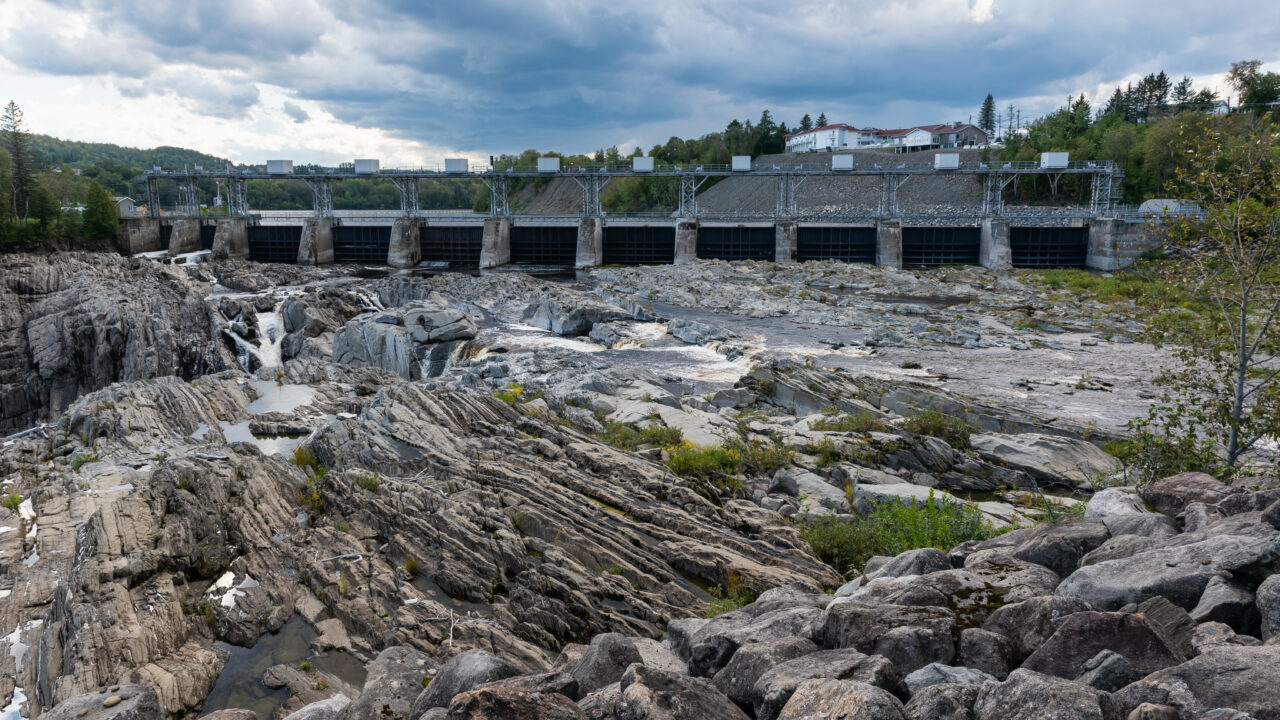 What remains of the Saint John River after the Grand Falls Generating Station in New Brunswick, Canada. Image: Adobe
What remains of the Saint John River after the Grand Falls Generating Station in New Brunswick, Canada. Image: Adobe
In the annals of decarbonization, few tales of progress are as chipper as the one New York City has told about its newly minted partnership with the hydropower industry. The keystone in the partnership is the Champlain Hudson Power Express, a 339-mile privately owned high-voltage transmission line to provide the city with electrons from the sprawling hydropower complexes of Canadian energy company Hydro-Québec. With the CHPE now under construction and slated to become fully operational by the spring of 2026, it has been celebrated as part of New York City’s grand transition to renewables — a “historic milestone,” said New York Mayor Eric Adams, “in our mobilization against climate change.” Elijah Hutchinson, executive director of Adams’ Office of Climate and Environmental Justice, told me in an email that the linking of the city’s grid to Hydro-Québec was “critical” to meet the goals laid out in the historic Climate Leadership & Community Protection Act that New York passed in 2019, which mandates that the state cut greenhouse gas emissions 40% by 2030 from 1990 levels, and 85% by 2050. New York Governor Kathy Hochul promises CHPE will “pav[e] the way for thousands of high-quality jobs, spurring billions in economic activity, reducing our dependence on fossil fuels, and ushering in a cleaner, greener New York for all.” Green groups that might be expected in other circumstances to oppose industrialization of the Hudson River — the project involves trenching the transmission line into a 90-mile stretch of the river bed — have opted to support CHPE, including Scenic Hudson and Trout Unlimited.
The claims about hydropower as a clean, green, sustainable power source issue with equal aplomb from government regulators, enviro journalists, climate academics and green-grid design wizards. Stanford engineer Mark Z. Jacobson sees hydropower as the linchpin for the realization of his vision of an advanced industrial society in which 100% of electricity comes from a combination of wind, solar and water. Hydro, said one recent CNBC report, is “the forgotten giant of clean energy,” because it’s already responsible for over 30% of renewable power generation in the U.S and roughly 70% globally. Michael Gerrard, faculty director of the Sabin Center for Climate Change Law at Columbia University’s law school and a vocal supporter of CHPE, claims that without Canadian hydropower New York will have to rely on more natural gas to maintain a reliable electrical supply. Absent what he describes as “a mind-boggling amount of new wind and solar, together with the associated transmission lines and storage facilities” — construction of which is unlikely in the near term — achieving the decarbonization goals the state has set for its electric grid will be impossible without help from Hydro-Québec. “From a climate perspective,” Gerrard told me, “hydropower is much superior to natural gas power.” Climate writer David Roberts agreed, writing in an email, “I’m a big hydro fan! I think most clean energy folks are, notwithstanding some concerns about salmon and such.”
The mega-reservoirs needed for industrial-scale hydroelectric production have displaced as many as 80 million people worldwide and adversely impacted some 470 million people living downstream of dam sites.
Viewed through the prism of fossil fuel emissions, it’s true that large-scale hydropower looks to be one of the more attractive options in the industrial energy lineup. But when viewed in a wider context, one that includes the “concerns about salmon and such,” a more complex, and uglier, picture emerges.
According to the World Commission on Dams, the mega-reservoirs needed for industrial-scale hydroelectric production have displaced as many as 80 million people worldwide and adversely impacted some 470 million people living downstream of dam sites. The U.N.’s Office of the High Commissioner for Human Rights reports that “resettlement for the displaced and the consequences on downstream livelihoods have led to the impoverishment of millions.” Indigenous people have “disproportionately suffered from these impacts in addition to the loss of their territories and cultural integrity,” according to the human rights agency.
Mega-reservoirs for hydropower have also displaced and destroyed wildlife, causing biodiversity collapses in which fish and other aquatic populations have disappeared almost overnight. The reservoirs have precipitated out of soils a poison, methylmercury, that bioaccumulates in fish and game that Indigenous groups, particularly in the boreal forests of Canada, depend on for survival outside the industrial food system.
This is only some of what we know for certain are the social and environmental costs of industrial-scale hydropower. Other likely costs remain unaccounted for, because concerted scientific studies haven’t been done. It’s known, for example, that by blocking the natural flow of rivers, dams prevent vital minerals from being scoured off river bottoms and banks to be deposited as nutrients in marine food webs. There’s no scientific consensus about the effect this nutrient starvation has had, say, on the largest coastal fisheries of the North Atlantic — the Georges Bank, the Grand Banks — but the evidence leans toward the very bad. In the Arctic, water vapor emissions from mega-reservoirs have caused regional increases in air temperature that may have contributed to the evanescing of ice on the Arctic Ocean, which in turn has accelerated planetary warming. If in fact water vapor emissions from mega-reservoirs can be tied to a warmed Arctic Ocean, hydropower in the Northern Hemisphere may be seen as merely another industrial culprit in climate collapse.
Hydropower’s consequences for Indigenous people explains the opposition to CHPE from the New York City Environmental Justice Alliance. Among the group’s reasons: Hydro-Québec’s “displacement of Indigenous communities, and the potential exposure of Indigenous communities to toxic organic mercury levels from dams,” EJA’s energy planner Daniel Chu explained in an email. The nonprofit Hudson Riverkeeper similarly has denounced CHPE for “bring[ing] power from massive hydroelectric dams in eastern Canada that have a long, devastating history of destroying rivers and damaging Indigenous communities.”
“Bring[ing] power from massive hydroelectric dams in eastern Canada that have a long, devastating history of destroying rivers and damaging Indigenous communities.”
Representatives from Indigenous tribes and groups with Indigenous ties across Quebec — including the Kitigan Zibi Anishnabeg, the Lac Simon Anishnabeg Nation, the Algonquin Anishnabeg Nation Tribal Council, the Cree from Mistissini, and the groups Labrador Land Protectors and Grand Riverkeeper Labrador — have signaled their staunch opposition to CHPE. For the Indigenous who have been swept under by the hydropower mega-complexes, their subjugation is central to what Daniel Macfarlane, a professor at Western Michigan University specializing in water history and policy and the environment, calls the “hydraulic imperialism” of the boreal forests, “whereby the Canadian state used waterways to exercise control” of vast landscapes, with the goal of facilitating industrial and agricultural development.
Over the last 40 years of its epic run of dam construction, the “immoral dealings” of Hydro-Québec — a wholly-owned subsidiary of the Quebec provincial government — “has cost my people everything; our heritage, our culture, our way of life and our future,” Lucien Wabanonik, a former grand chief of the Anishnabeg Nation Tribal Council, in Lac Simon, Québec, wrote in a recent op-ed. “New Yorkers need to know what’s happening in First Nation territories with hydroelectricity,” he said. Will Nicholls, a 61-year-old Cree journalist and editor-in-chief of Nationmagazinein Montreal, told me, “In our area, megadams are not the same as when you flood a narrow valley. Here they flood thousands of square kilometers. They’re creating inland seas! I will not be able to take my children to fish on those flooded lands. Those places are gone forever. I know that I was among the last of my people to drop a fishing line in those rivers.”

Modern dam building almost always involves disruption of Indigenous lifeways, according to Philip Fearnside, a research professor at the National Institute of Research in Amazonia in Manaus, Brazil, and an expert on hydropower. “Part of this is inherent in this energy option: concentrated impacts on riverside residents and indigenous peoples … versus diffuse benefits to distant beneficiaries,” Fearnside observed in a 2020 study of environmental justice and the hydropower industry in Amazonia. The benefits of the dams “accrue to urban consumers and especially to industries… This aspect is often written off by dam builders with the shibboleth ‘You have to break a few eggs to make an omelet.’” Of course, Fearnside added, this logic “is much easier to apply when the eggs to be broken refer to poor people … far from the centers of power and political influence.”
Holding 20% of the freshwater on Earth, Canada has exploited with great zeal its hydrological advantage. Today, the country produces 10% of the world’s hydroelectric power — behind only China and Brazil — and over half of that comes from a single province, Quebec, where Hydro-Québec operates hundreds of dams and impoundment reservoirs and scores of generating stations. The system’s most productive hydropower dam is named for celebrated Quebec Premier Robert Bourassa, Canada’s most devoted dam builder during the 1980s and 1990s. “Quebec is a vast hydroelectric plant in-the-bud,” Bourassa wrote in his 1985 book “Power from the North,” “and every day millions of potential kilowatt hours flow downhill and out to sea. What a waste!” His explicit goal was to create a surplus of power for sale to energy-profligate U.S. states abutting Canada.
Bourassa’s brainchild, the James Bay Hydroelectric Project, involved multiple hydropower dams on the La Grande River, including the flagship 5,600-megawatt Robert-Bourassa Generating Facility, and several others that diverted massive volumes of water from the Rupert, Eastmain, Opinaca and Caniapiscau rivers. By redirecting as many adjacent waterways as possible, engineers could carve out a single artificial basin that would augment the flow through generation sites on the La Grande. The area the project flooded was all wilderness, sacred to the James Bay Cree, and some 2.5 million acres of it disappeared forever. By the mid-1980s, the river that the Cree had known for thousands of years became, overnight, a technological artifact. Today, when the water in the La Grande finally reaches James Bay, a shallow marine inlet of Hudson Bay, its hydrograph — its seasonal flow cycle — has been irrevocably altered. This has had profound effects on the James Bay ecosystem and on the lifeways of the Cree who, only decades ago, lived mostly outside the industrial food system, surviving by hunting, trapping and fishing.
By the mid-1980s, the river that the Cree had known for thousands of years became, overnight, a technological artifact.
Last autumn, I reached out to talk with Indigenous researchers in Canada who have been applying traditional ecological knowledge to understand the ecological and climatic effects of megadams. I ended up talking with a 74-year-old Cree trapper named George Lameboy, founder and president of the Chisasibi Eeyou Resource and Research Institute, which operates at a remote camp north of the Cree town of Chisasibi, off the east coast of James Bay. The camp, located at one of 10 Cree traplines along the coast, consists of three wood-heated shacks. There’s a lab, a dormitory and a dining hall, which can also double as sleeping quarters. In the winter months, the snowbound site is reachable only after two hours on a snowmobile out of Chisasibi. CERRI has a singular purpose: to study the environmental effects of the derangement of the La Grande River’s hydrograph.
“Here it’s traditional knowledge that’s leading Western science,” Lameboy told me when I reached him via satellite link. “I’m sitting here one mile from the place where I was born, on the Kapsaoui River. I have trapped here all my life. I know this land. That’s what we’re tapping into.”
When the dams arose on the La Grande River, he said, there were odd and subtle changes on the landscape and in the wildlife. The direction of the wind changed along the coast of the bay, and there was a different taste in the fish. “Anyone in my age bracket will tell you that with the La Grande complex, one of the first things that changed was wind direction. Why? We don’t know. The quality of fish has gone down. It rots and goes bad. Cisco, lake white fish, speckled trout — they do not have the same richness of taste. The advantage of being 74 years old is to know the difference in that taste. Right now, Western science has not been able to give us full answers to what we’re seeing.”

One of Lameboy’s chief concerns is plummeting populations of marine birds. As early as 1990, the National Audubon Society had warned that the James Bay project would likely imperil avian habitat. With its extensive coastal marshes and intertidal flats, its critical habitat for shorebirds and waterfowl that migrate between northern breeding grounds and southern wintering areas, the birds “flock there by the millions in spring, summer and fall to feed, molt or nest,” said a 1990 Audubon Society report. “In many ways, James Bay is the northern equivalent of tropical rainforests.” The report predicted widespread decline of the birds once the La Grande River was dammed.
So it came to pass. After 1990, with the completion of the James Bay Project, geese populations started a long collapse, according to Lameboy. Geese are an important part of the traditional Cree diet. “The government says we overharvested, we killed too many. We think it’s the dams, because the dams are destroying the food supply for the geese.”
Among the immediate effects of the James Bay Project was the death of some 10,000 caribou that got trapped in rising water in the drawdown zone and were swept away.
Dante Torio, a marine biologist who works with Lameboy, says the geese decline is tied to failing eelgrass beds. Eelgrass has adapted to highly saline water and a particular type of river-deposited sediment. The dams on the La Grande River have upended the natural regime of salinity and sedimentation in which eelgrass thrived.
Other bird species, as the Audubon researchers predicted, seem to be disappearing from James Bay. According to Lameboy, populations of guillemot sea birds, red-throated loons and Atlantic brants — all traditional to the Cree diet — have fallen to the point they are rarely seen. “Was it coincidence that these bird species began collapsing right after the La Grande complex went into operation? We don’t think so,” Lameboy said.
By deranging a river’s hydrograph, dams can extend a zone of biological disorder for hundreds of miles along riverbanks. This occurs through what is referred to as the drawdown zone, or the land area frequently exposed to the air (and just as often submerged again) when reservoir levels rise and fall at rapid intervals as energy demand changes. Among the immediate effects of the James Bay Project was the death of some 10,000 caribou that got trapped in rising water in the drawdown zone and were swept away. These drastic changes in water levels lay waste to riverbank ecosystems, known as the riparian areas. It’s in the richly diverse riparian area that insects lay eggs and hatch their broods, amphibians nest and spawn, birds feed on insects, predators come to hunt and drink. But with unstable water levels, the biotic community is also made unstable, and descends into chaos, and over time the riparian is abandoned and becomes a ghost landscape.

Rivers are the lifeblood of oceans, and there’s plenty of evidence worldwide that dams have decimated coastal marine ecosystems by strangling the rivers that feed them. In a 2022 survey, researchers at the Chinese Academy of Sciences found that dams reduced sediment transport by as much as 92%, intercepted between 42% and 93% of all river nutrients, and slowed water velocity to such an extent that dammed rivers no longer effectively dissolve silicon from the weathering of rocks on land. Delivered to the sea, silicon nourishes the most common and important type of phytoplankton, the diatoms, which provide up to 40% of plant biomass in the marine food chain. Diatoms, floating near the ocean’s surface, are the green pastures without which marine wildlife could not thrive. They are also essential to the biogeochemical carbon cycle, absorbing as much as one-fifth of atmospheric CO2. According to NASA, the populations are declining. It may be that our widening chokehold on rivers is contributing to the destruction of a keystone species that keeps the oceans teeming with life.
Lameboy and Torio have also documented the disappearance of numerous species of ducks from the James Bay ecosystem. Those that are still thriving are not to be hunted, because they are likely poisonous to humans. Ducks feed on mussels, and mussels that grow in James Bay, in the plume of water from the La Grande River, have high concentrations of methylmercury.
Mercury sits harmless in soils when undisturbed, deposited over eons by geological events such as volcanic explosions (with some alarming additions by heavy industry). But when land is flooded, and oxygen levels plummet to produce anoxic conditions underwater, the mercury is drawn out of the soil by bacteria and transformed into the deadly toxin methylmercury. Exposure to methylmercury in humans can damage the brain and spinal cord in unborn babies and infants, producing a condition similar to cerebral palsy. It can produce a vast array of child development disorders, and in adults it’s a neurotoxin that can lead to severely impaired mental functioning, seizures, digestive and immune system malfunction, damage to the lungs and kidneys and, in large enough doses, death. The mercury from flooded lands continues to bioaccumulate in freshwater and oceans, promising long-term toxicity in the global fisheries food chain.
In 2016, a research team looked at the likely methylmercury concentrations from the Muskrat Falls dam project on the Churchill River, which was expected to be completed a year later. They projected a tenfold increase in methylmercury levels in the impounded water, and 2.6-fold increase in estuarine surface waters where the Churchill River debouched into Lake Melville on its way to the Labrador Sea. Ryan Calder, professor of population health sciences at Virginia Tech and the lead author of the study, told me the predictions were spot-on. Methylmercury is “now within or above the 90% confidence interval predicted by our 2016 paper at three upstream sampling locations and slightly below that interval at three downstream locations.” Calder looked at the effect on Canada’s Indigenous communities when health advisories led to abandonment of traditional hunted and fished diets. He found that the switch to store-bought foods would likely worsen health outcomes, because industrial food was simply not as nutritious.

Hydropower proponents like to say that the damage from the dams and reservoirs has already been done. No new dams need to be built, they claim, to provide electrons to New York City via CHPE, for example. But this may not be true. Hydro-Québec has signaled that its supply commitments, including those for New York, will require the company to find new capacity as early as 2026. Researchers at Harvard concluded, in a 2016 study, that over 90% of potential new hydroelectric projects in Canada were “likely to increase concentrations of … methylmercury in food webs near indigenous communities.”
When asked about concerns about megadam development during an interview at an open house informational event in New York City, Hydro-Québec’s Peter Rose, senior director of stakeholder relations, told me, “When it comes to methylmercury, the levels are safe. When it comes to carbon emissions, there are none. We did a hundred-year life cycle analysis and found greenhouse gas emissions on par with wind power.” He added in an emailed statement, “There are zero cases of mercury poisoning from fish consumption in Québec (to our knowledge).”
One of the more impassioned dissenters against a U.S. partnership with Hydro-Québec is a retired mechanical engineer and home builder from Maine named Stephen Kasprzak. Kasprzak, who will turn 81 this year, has fought what he calls “the unnatural flow regulation of hydroelectric dams” since the 1980s, when a paper company decided to reduce summer and fall discharges from Eel Weir Dam on Maine’s Sebago Lake, where he owned a cottage for 40 years. The company’s intention was to raise lake levels enough to provide high-value winter hydropower for its paper mill. But it didn’t take into account one of the unfortunate consequences of the raised water levels: massive erosion of shorelines and Maine’s most outstanding inland beaches.
Kasprzak is an obsessive fly fisherman. Sometimes he fishes twice a day. Threats to the health of aquatic ecosystems make him ornery. “What I understood is that damming water is bad, water needs to run free,” Kasprzak told me. He filed a formal complaint to the Federal Energy Regulatory Commission, alleging that the paper company had violated its FERC license by raising water levels without approval. FERC did nothing to restore the historic levels, and the erosion continues to this day.
“I think this whole discussion is a game-changer in how we approach climate issues.”
On an afternoon last October that felt too warm for the season, I went to hear Kasprzak present his findings about megadams at the University of Massachusetts at Lowell. Kasprzak had been invited by the head of the school’s physics department, Robert Giles, who had reviewed his research and found it compelling enough that the students in his honors class, Energy and the Developing World, needed to hear it.
Kasprzak brought with him a dozen copies of a self-published book, “Arctic Blue Deserts,” which he distributed to the students. He had spent $50,000 for a run of 3,000 copies. “This is how much I believe in getting this out in the world,” he told me. He intended the 260-page treatise, as he explained in the introduction, to be “a counter narrative” about the “dramatic climate change facing the Arctic, caused in large part I believe, by the impact of mega reservoir hydroelectric dams radically altering the region’s natural water cycle.” Kasprzak, Giles told me, had marshaled “amazing data” in the book. “People have got to hear his message,” said Giles. “I think this whole discussion is a game-changer in how we approach climate issues.”

Kasprzak launched into the counter narrative, with a series of PowerPoint slides that opened with black and white photos of the massive hydropower complexes built in Soviet Russia in the 1950s. It was the Soviets, he explained, who first understood the climatic implications of stoppering rivers and backing them up to create inland seas. By 1955, in a stunning instance of environmental hubris, the Soviet government had made clear its goal of warming the region by the creation of these inland seas. Rivers of immense volume and length, such as the Ob, Yeniseiand Angara, would be transformed into bodies of inert water heated by the sun, the water evaporating in greater volume to produce water vapor emissions, a powerful greenhouse gas.
“Astonishing climatic change would occur,” trumpeted Radio Moscow in August of 1958. “Evaporation (from the inland sea) would increase and with it the humidity of the air. The extremes of yearly and daily temperature characteristic of these would be greatly modified.” The most important modification from the increase in heat-trapping humidity was the warming of the Arctic climate and the melting of the icebound ports on the Kara and Laptev seas, the extensions of the Arctic Ocean along the Siberian coast. The Soviets had long desired to extend their imperial reach with the establishment of military terminals that had year-round access to the Arctic. They also suggested that regional warming would make mineral exploration easier in the Arctic. Regional warming would even facilitate the production of crops with an expanded growing season.
The extent of Arctic sea ice is one of the most powerful mechanisms regulating ocean temperatures. Arctic warming is proceeding at a rate four to five times the global average. What if it turns out that the Arctic has been warmed by mega-reservoir hydropower? It would explain a lot. Consider, in this context, the enigma of Antarctic sea ice: in most areas it is growing in extent, confounding scientists whose climate models predicted exactly the opposite. The growth of Antarctic sea ice area stands in stark contrast to conditions in the Arctic, where the August extent of sea ice has declined by 2.9 million square miles over the past 40 years, a 37% drop — and one much greater than envisioned in climate models.
What if it turns out that the Arctic has been warmed by mega-reservoir hydropower?
There is no consensus as to the causes of this Arctic amplification. But we do know that the region’s accelerated warming began in the 1970s. Kasprzak’s question is this: Was that coincidental or attendant to the construction of mega-reservoir hydropower complexes 15 years earlier? Among the evidence Kasprzak uncovered in his research: Annual average temperatures from multiple Russian weather stations, in the Kara Sea’s watershed in Siberia, reveal hinge points of unprecedented and extreme warming trends beginning in the 1950’s — directly after the stoppering of the rivers, the Ob and Yenisei, that feed the Kara. The Kara Sea is now the fastest warming ocean body in the world. According to the Russian Federal Service for Hydrometeorology and Environmental Monitoring, the air temperature around the sea has increased 9 degrees Fahrenheit from 1998 to 2018. The Soviets wanted an ice-free Kara Sea. They succeeded. The Kara (along with the Laptev) has been called the ice factory of the Arctic Ocean and is one of the regulators of Arctic Ocean circulation and ice extent. A warmer Kara Sea means a warmer Arctic, which means a warmer planet.
Kasprzak wrapped up the presentation and we got lunch with Giles and another attendee, a UMass-Lowell professor emeritus of mathematics named Lee Jones. Jones specializes in probability statistics and pattern recognition and had taken a keen interest in the material in “Arctic Blue Deserts.” He had said a few words to the class before Kasprzak spoke. He noted that land temperatures agree well with predictions from CO2 concentration for the Southern Hemisphere. For the Northern Hemisphere, however, the rate of land warming has been approximately double that predicted by CO2 concentrations.
If CO2 concentration were the sole driver, Jones told me at lunch, the likelihood of the difference in observed Northern Hemisphere warming, using a robust mathematical time series, was about one in a thousand. “Climate specialists are arguing that in the North, because of methane emissions and increased water vapor, CO2 is only 70% of the greenhouse effect,” Jones told me. “So, if we plot northern land temperature versus greenhouse gas predictions, we see that only 80 to 90% of the warming is accounted for.” Jones said he was working on a statistical verification, using weather station data, of Kasprzak’s theory that in fact mega-reservoir hydropower has been one of the drivers of northern warming. “I think he’s onto something,” said Jones.

A few weeks after the presentation at UMass, I drove up from New York to meet with Kasprzak at his home in Kennebunkport. He was joined by his old friend and research partner, Roger Wheeler, a 70-year-old retired middle school teacher. Wheeler was driven to take on hydropower dams for the same reasons as his friend: He had seen what had happened on Sebago Lake, where his family had owned a cottage since 1909.
We sat at Kasprzak’s computer and he walked us through the data, the charted temperature changes, the correlation with the construction of Soviet megadams, the hinge points. If all this is shown to be true for the inland seas of the hydropower complexes of Siberian Russia, then why, asks Kasprzak, would it not also be true for the inland seas of the complexes in Canada? Is there a possibility that regional warming in Canada driven by megadams is having an effect on global climate? “We need science to have a free discussion of this,” he told me. “If we’re wrong, please show us how.”
Kasprzak is not alone in his quest to publicize this facet of what he calls “the true story” behind boreal megadams. Roberta Benefiel, co-director of the Grand Riverkeeper in Labrador and a founding member of the North American Megadam Resistance Alliance, told me her organizations had gathered “tons of data from NOAA that show the upward trajectory of temperature in the Arctic at the exact same time as the biggest dams and reservoirs were brought on stream.” She added, “These are global issues, and what we have learned from our research needs to be taken seriously and reported widely.”
It turns out that hydropower has a serious greenhouse gas problem. The total amount of vegetation swallowed in a mega-reservoir is key to understanding this greenhouse gas output. When you dam a narrow mountain valley for power production in a place like Switzerland or Iceland, it’s pretty good for the climate when compared to the equivalent kilowatt-hour emissions from a natural gas plant and certainly against a coal-fired plant. That’s because at high elevations in Switzerland and Iceland there’s little vegetation that’s been submerged and made to rot.
In Canada, the inland seas of megadams cover sprawling boreal forests and bogs. For its part, the hydropower industry admits that a one-off blast into the atmosphere occurs as the vegetation decomposes, a surprisingly large spewing of CO2 and methane. But it claims the emissions quickly dissipate. Scientists are increasingly calling these claims into question. A research team at the Institute of Environmental Engineering in Zurich found that the GHG footprint of hydropower “is far higher than previously assumed,” and in individual cases some reservoirs “can reach the same emission rates as thermal power plants.” The results of their research, they said, “question the sustainability that is often associated with hydropower.” Taylor Maavara, a freshwater biogeochemist at the University of Leeds in the U.K. who has looked at the environmental effects of the industry, says that it’s “misleading” to “laud dams as the most viable sustainable energy source in the era of climate change.”
The GHG footprint of hydropower “is far higher than previously assumed,” and in individual cases some reservoirs “can reach the same emission rates as thermal power plants.”
Brad Hager, a geophysics professor at MIT, has spent a decade investigating the greenhouse gas emissions of hydropower in Canada. The most relevant data he found are measurements made by Hydro-Québec of the CO2 emissions resulting from the flooding, in 2006, of 230 square miles of virgin forest and wetlands in anticipation of future demands for hydropower such as CHPE. In the first year after impoundment, the new Eastmain-1 reservoir emitted as much CO2 as would have been released by a coal-fired power plant generating the same amount of electricity.
Measurements the following three years were lower. Hydro-Québec projected that excess emissions decrease exponentially with time and are negligible within a decade, resulting in cumulative CO2 emissions of Eastmain-1 over a century almost half of those from natural gas. However, Hydro-Québec’s more recent measurements through 2012 show no significant decline after the first year, contradicting their claim that the excess emissions decay rapidly. Independent analyses of “transient” emissions from new reservoirs globally find that they go on for half a century. Hager concludes that the Eastmain-1 emissions, and those from the additional 130 square miles of virgin forest and wetlands flooded by diversion of the Rupert River into the Eastmain, completed in 2011, are “at least half as dirty as gas — something of an improvement,” but in no way climate friendly.
In a 2016 study published in the journal PLoS ONE of the greenhouse gas emissions of approximately 1,500 hydropower facilities worldwide, researchers at the Institute of Environmental Engineering, in Zurich, ranked six of Hydro-Québec’s mega-reservoirs among the top 25% of greenhouse gas emitters worldwide. The emissions of the six reservoirs ranged from roughly that of a natural gas power plant (about 400 grams of CO2-equivalent per kilowatt-hour) to more than twice that of coal-fired power plants (about 1,000 grams of CO2-equivalent per kilowatt-hour). The greenhouse gas footprints of some of Hydro-Québec’s power stations — as documented, Hager was careful to note, in the peer-reviewed scientific literature — “make it among the dirtiest hydro in the world.”

Studying mega-reservoir dams in South America, Philip Fearnside, the research professor at the National Institute of Amazonian Research, has declared them to be “methane factories.” This is a big impediment to bending the emissions curve to keep warming below catastrophic levels, given that methane is a far more potent greenhouse gas than CO2 when measured during the time window, the next 20 years, when the curve needs to bend the most. “Dams in tropical forest areas like the Amazon often have large drawdown zones in which easily composed herbaceous plants can grow quickly when the water level of the reservoir falls,” Fearnside reports. “These plants decompose at the bottom of the reservoir when the water level rises again, thus producing methane gas.” This source of methane is permanent, never diminishing, “unlike the large initial emission peak from the decomposition of carbon from the soil, vegetation, and litter of the original forest that takes place after the forested area is flooded.”
The world is today plunging forward with planned or current construction of more dams than at any time since the 1960s. The driving force behind the dam boom is the Paris Climate Accords and the U.N.’s Clean Mechanism Rule, which incentivizes nations and investors to plumb the world’s rivers so as to appear to be mitigating the disastrous planetary warming trend. Much of the construction is in the tropics, where methane emissions are greatest. “Building tropical megadams,” Fearnside told me in an email, “is the worst energy option in terms of social injustice, biodiversity loss and emission of greenhouse gasses during the narrow time window when global warming must be contained.”
Roberta Benefiel, who is 77, lives in Happy Valley-Goose Bay, home of the Churchill Falls Generating Station, which backs up the Churchill River, once called by the Innu the Mishta-shipu, the Grand River. That first dam on the Churchill was the beginning of its end, flattening its white-capped rapids and raging waterfalls. Benefiel doesn’t presume to speak for the Indigenous people who have been driven from the river and whose traditional foods have been toxified. But the rural whites and the Indigenous share a common feeling: They have lost a place that was beloved and sacred, a wild river with its abundance of riparian life. A second dam, Muskrat Falls, was completed in 2020 further down the Churchill River, and a third, the Gull Island Dam, is in the planning stage, with the government of Newfoundland and Labrador in discussion with Hydro-Québec to feed more electrons into the grid for sale to Canadian cities and the United States.
They have lost a place that was beloved and sacred, a wild river with its abundance of riparian life.
Benefiel thinks it is time industrialized societies reconsider their assumptions about taking from the wild hinterlands to serve the hubs of civilization. Those who live under the shadow of the dams and in the destruction zone of the reservoirs wonder why they must sacrifice so that people in cities like New York can benefit. They wonder why the people in New York don’t make sacrifices. This is a sentiment I’ve heard repeatedly when interviewing land and water defenders, especially Native Americans, who suggest that affluent urbanites at the apex of the technological megamachine may need, in the face of our ecological crisis, to tighten their belts, contract their power usage, reduce their material footprint and start putting into effect some measure of austerity that nontechnologized, nonindustrialized people practice on a daily basis. I put this idea to Hydro-Québec booster Michael Gerrard at Columbia’s Sabin Center. “I understand the sentiment,” Gerrard replied, “but there is no imaginable pathway for a densely populated metropolitan area like New York to begin practicing this kind of austerity.”
Gerrard might as well be saying that the energy privileges of New Yorkers are non-negotiable. The pressing issue, with planetary warming on a catastrophic trajectory, is that these privileges now need to be greened. “Environmentalists glom on to this green energy idea as though we in the Western world can continue living high on the hog,” Benefiel told me. “All we have to do is switch the type of power we use. Those are false solutions. We don’t consider the fact that we absolutely cannot continue to live this way. We have to scale down.”
This article was produced in collaboration with the Food & Environment Reporting Network, an independent, nonprofit news organization.
Your support is crucial…With an uncertain future and a new administration casting doubt on press freedoms, the danger is clear: The truth is at risk.
Now is the time to give. Your tax-deductible support allows us to dig deeper, delivering fearless investigative reporting and analysis that exposes what’s really happening — without compromise.
Stand with our courageous journalists. Donate today to protect a free press, uphold democracy and unearth untold stories.
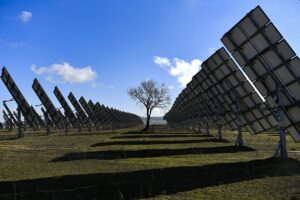
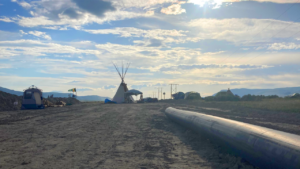

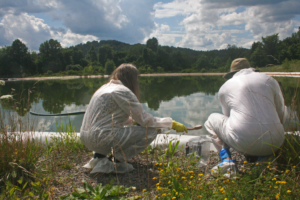
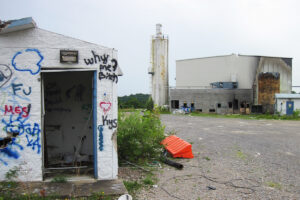

You need to be a supporter to comment.
There are currently no responses to this article.
Be the first to respond.